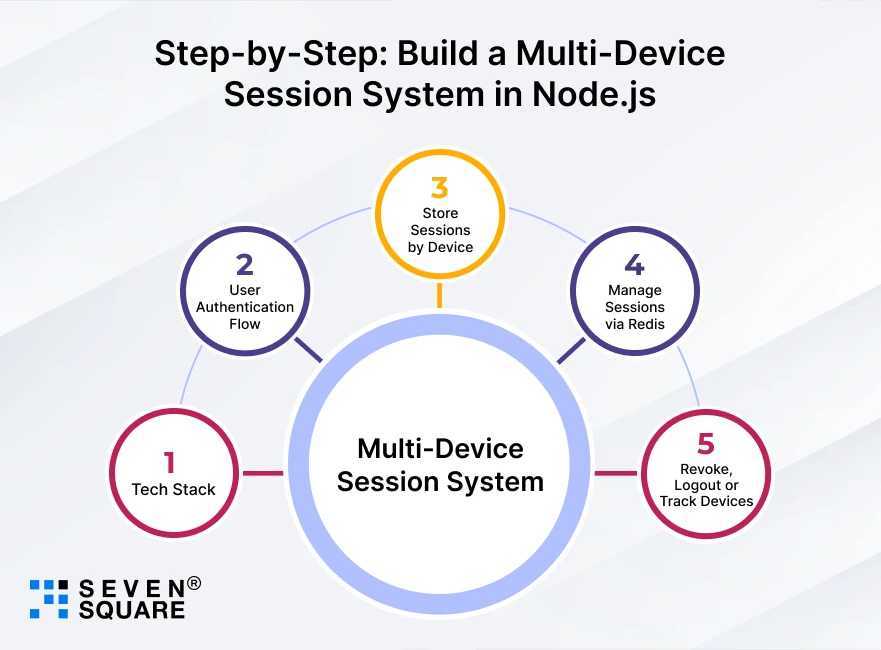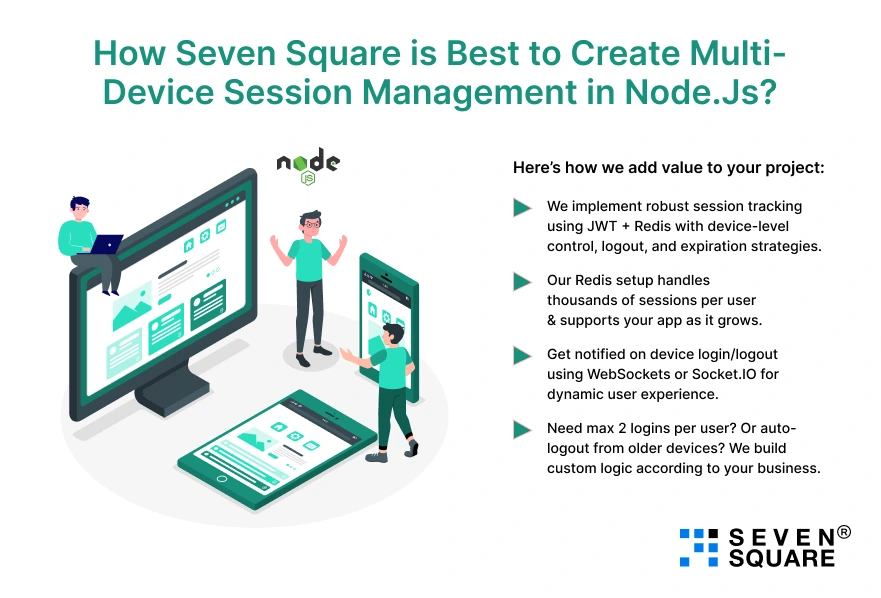Users expect to log in to your app from their phone, tablet, or laptop, and switch smoothly without any breaks.
Whether it’s a shopping app, SaaS dashboard, or a messaging tool, multi-device login is a basic need.
But here’s the catch: managing user sessions across multiple devices is not as straightforward as a simple login system.
You need to track sessions per device, handle security risks like hijacking, and offer users control like logging out from specific devices.
Here in this blog, we will try to explain how to implement multi-device session management in Node.js, using tools like Express and Redis.
With a step-by-step guide for Node.js session management, you’ll learn how to:
- Handle multi-device login in Node.js.
- Track and manage concurrent sessions.
- Build a secure, scalable Node.js session management system.
What Is Multi-Device Session Management?
Multi-device session management allows your app to recognize and manage each user session on a per-device basis. It’s the system behind features like:
- Seeing where you’re logged in (e.g., WhatsApp Web, Gmail, & Netflix).
- Remotely logging out of other devices.
- Detecting unauthorized logins on new devices.
Apps like WhatsApp, Google, or banking platforms, track which devices a user is logged in on and let them manage those sessions easily.
That’s the power of multi-device session tracking. The benefits include:
- Better security through device-specific session control.
- Improved user experience.
- Support for concurrent session handling so users can be logged in on multiple devices without conflicts.
This becomes especially important for B2B apps, admin portals, or collaborative tools where multiple logins are standard.
How Node.js Handles Sessions (A Quick Overview)?
By default, Node.js (especially with Express) uses sessions stored in memory or via middleware like express-session.
These sessions are tied to cookies that identify the user. However, in a multi-device setup, simple session cookies aren’t enough. Why?
Because you need to associate multiple sessions with a single user and distinguish them by device.
That’s where a session store like Redis shines. Redis lets you:
- Store sessions in a persistent, fast-access database.
- Group multiple sessions under a single user ID.
- Invalidate sessions across one or more devices easily.
In short, proper Node.js session handling with Express sessions and Redis is the foundation for multi-device support.
System Design: Multi-Device Session Architecture
Let’s see how a multi-device session system works in Node.js:
Architecture Flow:
User → Auth Endpoint → Server → Session Store (Redis) → Device Session Mapping
Every time a user logs in:
- A new session (or token) is created.
- It’s tagged with the device ID.
- The session is saved in Redis & mapped to the user.
This setup allows actions like:
- Logging out from one or all devices.
- Listing active sessions with timestamps.
- Secure session validation per device.
Key Considerations:
- Scalability: Redis allows high-speed storage of thousands of sessions.
- Security: Encrypt tokens, validate device fingerprints.
- Isolation: Each device/session is independent, reducing risk.
This architecture is the core of a secure multi-device login system in Node.js, and it supports future scaling.
Step-by-Step: Build a Multi-Device Session System in Node.js

Learn to build a fully working multi-device session management system using modern tools and best practices.
Step 1: Tech Stack
- Node.js: Backend runtime
- Express.js: Server framework
- Redis: Stores sessions per device
- JWT: For stateless authentication
- UUID: To identify devices uniquely
This combination gives you a flexible, scalable, and secure setup.
Step 2: User Authentication Flow
- User logs in via /login with credentials
- A JWT token is generated along with a device ID
- JWT + Device ID is stored in Redis against the user ID
- All requests from that device must send the JWT
Learn to build token-based authentication in NodeJs with JWT.
Step 3: Store Sessions by Device
Each session is tied to a unique device identifier (UUID). This helps us distinguish between mobile, web, tablet, etc.
Here’s how to generate and use it:
const { v4: uuidv4 } = require('uuid');
// When user logs in
const deviceId = uuidv4(); // Unique per device
const token = jwt.sign({ userId }, process.env.JWT_SECRET);
// Store session in Redis
await redisClient.hset(`sessions:${userId}`, deviceId, token);
This creates a Redis hash like:
sessions:user123
├── device_1: token123
└── device_2: token456
Step 4: Manage Sessions via Redis
Redis lets you:
- View all active sessions for a user
- Track sessions per device
- Remove or update tokens easily
To fetch all devices:
const sessions = await redisClient.hgetall(`sessions:${userId}`);
console.log("Active Devices:", Object.keys(sessions));
Step 5: Revoke, Logout or Track Devices
Need to log out a user from one device or all?
Revoke all sessions except current:
const sessions = await redisClient.hgetall(`sessions:${userId}`);
for (const device in sessions) {
if (device !== currentDeviceId) {
await redisClient.hdel(`sessions:${userId}`, device);
}
}
Logout from specific device:
await redisClient.hdel(`sessions:${userId}`, targetDeviceId);
This is multi-session user management in Node.js simplified as Redis is doing the heavy lifting for session tracking.
Explore the full GitHub code for multi-device sessions in Node.js.
How Seven Square is Best to Create Multi-Device Session Management in Node.Js?

We’ve helped startups, enterprises, and SaaS businesses build secure, scalable, and real-time session management systems that work smoothly across devices.
Whether you’re launching a messaging app, SaaS dashboard, or admin panel, we know exactly how to implement and optimize multi-device login in Node.js using production-ready code.
Here’s how we add value to your project:
- We implement robust session tracking using JWT + Redis with device-level control, logout, and expiration strategies.
- Our Redis setup handles thousands of sessions per user & supports your app as it grows.
- Get notified on device login/logout using WebSockets or Socket.IO for dynamic user experience.
- Need max 2 logins per user? Or auto-logout from older devices? We build custom logic according to your business.
Want a fully customized NodeJs app? Contact Us Now!
Use Cases & When to Implement Multi-Device Sessions
You should consider implementing multi-device session management in your Node.js app if:
- You’re building a SaaS platform with admin/user logins.
- Your app runs across devices like messaging tools or e-learning platforms.
- Your users expect to manage sessions (e.g., logout from all devices).
If your app only supports single-device use or doesn’t require concurrent logins. Always assess user needs and project scale.
FAQs
- Multi-device session management in Node.js allows users to log in from multiple devices (like phones, laptops, or tablets) while tracking and managing each session separately.
- This is useful for SaaS tools, messaging platforms, and admin panels.
- Redis is a fast, in-memory data store ideal for session management because it supports quick read/write operations.
- It allows efficient Node.js session tracking with Redis, supports large-scale session storage, and lets you map tokens to specific device IDs.
- You can manage multi-session handling by generating a unique device ID and storing JWT tokens per device in Redis.
- This way, each device maintains its own session without interfering with others.
- Yes. Using the device ID stored in Redis, you can delete just that session entry.
- This is helpful for building features like “Log out from this device” or revoking unauthorized access.